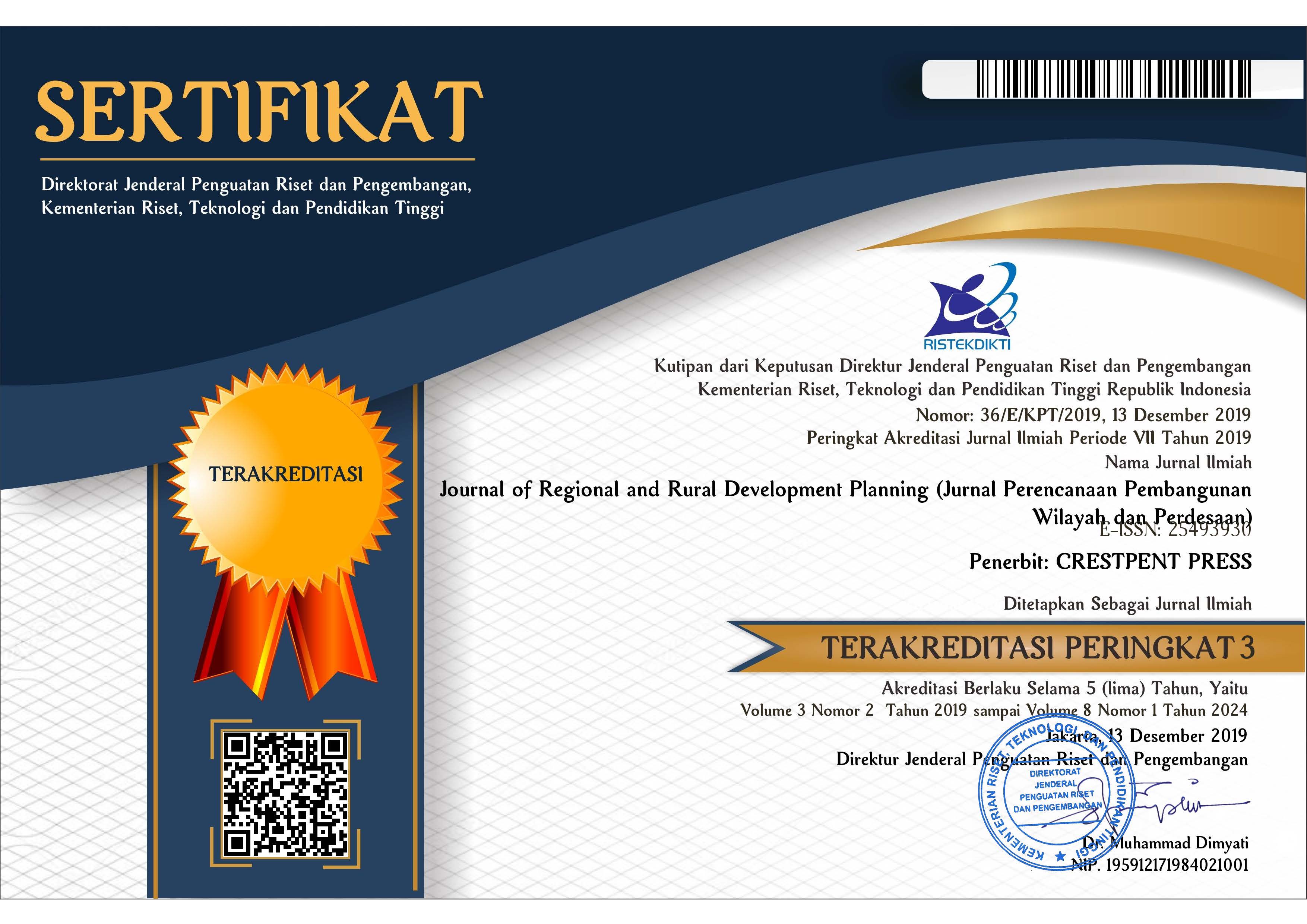Analysis of Sustainable Livelihood level and its Influence on Community Vulnerability of Surumana Village, Central Sulawesi
Abstract
Sustainable livelihood is an activity that can help households in meeting their needs for survival. However, frequent flooding, increase in population growth each year, lack of facilities that support livelihoods such as education and health facilities, has made community’s livelihoods decline. Frequent flood results in reduced agricultural production. As a result, resources available at the research site become unbalanced. Therefore, this study aims to formulate a village development concept based on sustainable livelihood. This research was conducted in Surumana Village, Donggala Regency, Central Sulawesi Province by using primary and secondary data with a sample of 82 households. Likert scale was employed to measure one’s or group’s attitudes, opinions, and perceptions regarding social events or symptoms experienced. Besides, the Delphi method was also employed and used to gather opinions from experts through questionnaires with feedback mechanism while maintaining the anonymity of experts’ responses. The study result show that the maximum resource strength is found in social capital. Meanwhile, the vulnerability that affects resources in Surumana Village is flooding. In addition, the factors that support realization are institutions, education, health, transportation, reducing flooding, and increasing agricultural production.
References
Adi, I. R. (2007). Perencanaan Partisiporis Berbasis Aset Komunitas. Dari Pemikiran Menuju Penerapan. PT Raja Grafindo Persada.
Adisasmita, R. (2013). Teori-teori Pembangunan Ekonomi. Graha Ilmu.
Baiquni, M. (2007). Strategi Penghidupan di Masa Krisis. Ideas Media.
Bezemer, D. J. & Lerman, Z. (2002). Rural Livelihoods in Armenia: The Centre for Agricultural Economic Research, the Department of Agricultural Economics and Management Discussion Paper No. 4.03
Bhaduri, S., Sinha, K. M. & Knorringa, P. (2018). Frugality and cross-sectoral policymaking for food security. NJAS - Wageningen Journal of Life Sciences, 84, 72–79.
Brunnhofer, M. (2020). The biorefinery transition in the European pulp and paper industry – A three-phase Delphi study including a SWOT-AHP analysis. Forest Policy and Economics, 110.
Chambers, R. & G. Conway. (1992). Sustainable rural livelihoods: Practical Concepts for The 21st Century. IDS Discussion Paper 296. Brighton: IDS. (pp.7-8). 33.
DFID. (1999a, 2000d, 2001). Sustainable livelihoods guidance sheets. Retrieved from www.livelihoods.org
DFID. (2001). Sustainable Livelihoods Guidance Sheets. Eldis Document Store.
DFID. (2003). Achieving Sustainability: Poverty Elimination and the Environment, Strategies for Achieving the International Development Targets. Department for International Development.
DFID. (2005). Sustainable Livelihoods Guidance Sheets. Department for International Development (UK). London. diakses di: http://www.livelihoods.org/info/info_guidancesheets.html tanggal 2 April 2012
Endang, S. S. (2011). Kertas Pedoman Penghidupan Berkelanjutan. Program Studi Kependudukan Pascasarjana UGM. 92.
Ellis, F. (2000). Rural Livelihoods and Diversity in Developing Countries. Oxford University Press
Faiz, A., Faiz, Aysha., Wang, W. & Bennett, C. (2012). Sustainable rural roads for livelihoods and livability. Procedia-Social and Behavioral Sciences, 53, 1–8.
Fauzi A. (2004). Ekonomi Sumberdaya Alam dan Lingkungan: Teori dan Aplikasi. Gramedia.
Farrington, J., T. Ramasut, J. Walker, (2002). Sustainable Livelihoods Approaches in Urban Areas: General Lessons, with Illustrations from Indian Cases. ODI.
Formetta, G. & Feyen, L. (2019). Empirical evidence of declining global vulnerability to climate-related hazards. Global Environmental Change, 57.
Fukuyama, F. (1995). Trust: Social Virtues and the Creation of Prosperity. Free Press.
Greene, C. (2018). Broadening understandings of drought–The climate vulnerability of farmworkers and rural communities in California (USA). Environmental Science & Policy, 89, 283–291.
Harpe, S. E. (2015). How to analyze Likert and other rating scale data. Currents in Pharmacy Teaching and Learning, 7 (6), 836–850.
Kollmair & Gamper (2002).Input paper for the Integrated Training Course of NCCR North-South Aeschiried, Swifter land (9-20,Sep,2002)
Lemhannas. (1997). Ketahanan Nasional. PT. Balai Pustaka.
Maas, L. T., Sirojuzilam, E., & Badaruddin. (2015). The Effect of Social Capital on Governance and Sustainable Livelihood of Coastal City Community Medan. Procedia-Social and Behavioral Sciences, 211, 718 – 722.
Matridi, R. A., Zuraidi, D., Setyadiharja, R., Sanopaka, E., Effendi, D. & Utari, D. S. (2014). An Evaluation of P3DK (An Acceleration of Development Village Program): A Reviewing on Failure toward Revolving Loan Fund System in Kepulauan Riau Province, Indonesia. Procedia-Social and Behavioral Sciences, 169, 189–197.
Mekonnen, Z., Woldeamanuel, T. & Kassa, H. (2019). Socio-ecological vulnerability to climate change/variability in central rift valley, Ethiopia. Advances in Climate Change Research, 10 (1), 9–20.
Michellier, C., Kervyn, M., Barette, F., Syavulisembo, A. M., Kimanuka, C., Mataboro, S. K., Hage, F., Wolff, E. & Kervyn, F. (2020). Evaluating population vulnerability to volcanic risk in a data scarcity context: The case of Goma city, Virunga volcanic province (DRCongo). International Journal of Disaster Risk Reduction, 45.
Núñez, S. (2014). Application of a Model based on the Use of DELPHI Methodology and Multicriteria Analysis for the Assessment of the Quality of the Spanish Dry Ports Location. Procedia-Social and Behavioral Sciences, 162, 42–50.
Saragih, S., Lassa, J. & Ramli, A. (2007). Kerangka Penghidupan Berkelanjutan. https://www.zef.de/fileadmin/user_upload/2390_SL-Chapter1.pdf (18/02/2012)
Saleh, A. (2016). Concept of Village Regrouping as an Alternative Strategy for Sustainable Micro Regional Development. Procedia-Social and Behavioral Sciences, 216, 933 – 937.
Scoones, I. (1998) ‘Sustainable Rural Livelihoods: A Framework for Analysis’, Working Paper 72, Brighton, UK: Institute for Development Studies.
Sugandhy, A. & Hakim, R. (2007). Prinsip Dasar Kebijakan Pembangunan Berkeanjutan Berwawasan Lingkungan. Bumi Aksara.
Suharto. E. (2007). Kebijakan Sosial Sebagai Kebijakan Publik. Alfabeta.
Tamangb, Dorje, D., Udasa, P. B., Unnic, A., Hamala, M., Shresthad, K., & Pandite, A. (2019). Basin level gendered vulnerabilities and adaptation: A case of Gandaki River Basin. Environmental Development, 31, 43–54.
Tjokrowinoto. (1996). Pembangunan Untuk Rakyat. PT. Pustaka Cidesindo.
UNDP. (2007). Modul Pembelajaran Pendekatan Penghidupan Berkelanjutan Bagi Perencana dan Pegiat Pembangunan Daerah. UNDP. 176.
Villágran, D. L. J. C. (2006). Vulnerability A Conceptual and Methodological Review - Studies of the University: Research Counsel Education UNU-EHS. Institute for Environment and Human Security No. 4/2006.
Vonglao, P. (2017). Application of fuzzy logic to improve the Likert scale to measure latent variables. Kasetsart Journal of Social Sciences, 38, 337–344.
WCED. (2008), Our Common Future. World Commission on Environment and Development. Oxford University Press.
Wijayanti, R. (2018). Strategi Penghidupan Berkelanjutan Masyarakat Berbasis Aset di Sub DAS Pusur, DAS Bengawan Solo. Jurnal Wilayah Dan Lingkungan, 4 (2), 133–152.
Copyright (c) 2020 Journal of Regional and Rural Development Planning (Jurnal Perencanaan Pembangunan Wilayah dan Perdesaan)

This work is licensed under a Creative Commons Attribution-ShareAlike 4.0 International License.




.png)














